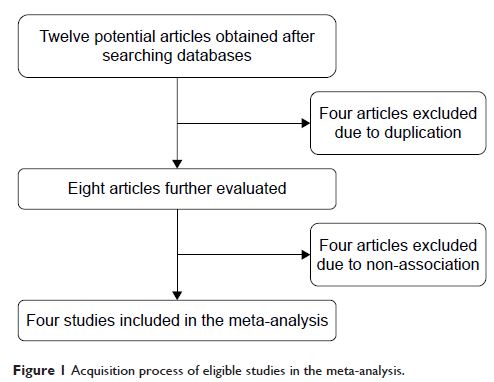9 0 8 0 2
论文已发表
注册即可获取德孚的最新动态
IF 收录期刊
- 2.6 Breast Cancer (Dove Med Press)
- 3.9 Clin Epidemiol
- 3.3 Cancer Manag Res
- 3.9 Infect Drug Resist
- 3.6 Clin Interv Aging
- 4.8 Drug Des Dev Ther
- 2.8 Int J Chronic Obstr
- 8.0 Int J Nanomed
- 2.3 Int J Women's Health
- 3.2 Neuropsych Dis Treat
- 4.0 OncoTargets Ther
- 2.2 Patient Prefer Adher
- 2.8 Ther Clin Risk Manag
- 2.7 J Pain Res
- 3.3 Diabet Metab Synd Ob
- 4.3 Psychol Res Behav Ma
- 3.4 Nat Sci Sleep
- 1.9 Pharmgenomics Pers Med
- 3.5 Risk Manag Healthc Policy
- 4.5 J Inflamm Res
- 2.3 Int J Gen Med
- 4.1 J Hepatocell Carcinoma
- 3.2 J Asthma Allergy
- 2.3 Clin Cosmet Investig Dermatol
- 3.3 J Multidiscip Healthc

已发表论文
常见的 EFEMP1 基因单核苷酸多态性(SNP)与中国人脑胶质瘤风险的关系
Authors Hu J, Dong D, Lu DD
Received 9 June 2017
Accepted for publication 14 September 2017
Published 6 November 2017 Volume 2017:10 Pages 5297—5302
DOI https://doi.org/10.2147/OTT.S143610
Checked for plagiarism Yes
Review by Single-blind
Peer reviewers approved by Dr Narasimha Reddy Parine
Peer reviewer comments 2
Editor who approved publication: Dr Yao Dai
Background: Although the
associations between common single nucleotide polymorphisms (SNPs) of EFEMP1 gene and glioma risk
have been investigated in Chinese population-based case–control studies,
investigation results for several SNPs are inconsistent. In addition, the
single-center study has a poor statistical power due to finite sample size.
Therefore, a meta-analysis was conducted to comprehensively determine the
associations.
Methods: All eligible case–control studies were obtained by searching PubMed, EMBASE, Web of Science, and Chinese National Knowledge Infrastructure. Pooled odds ratio (OR) with 95% confidence interval (CI) was used to assess the strength of the associations in fixed- or random-effects model.
Results: EFEMP1 rs1346787 polymorphism was significantly associated with glioma risk in Chinese population under all genetic models (GG vs AA, OR =2.22, 95% CI =1.46–3.36; AG vs AA, OR =1.54, 95% CI =1.27–1.87; (GG+AG) vs AA, OR =1.60, 95% CI =1.34–1.93; GG vs (AG+AA), OR =1.86, 95% CI =1.24–2.78; G vs A, OR =1.54, 95% CI =1.32–1.79). However, the significant association of EFEMP1 rs1346786 with glioma risk in Chinese population was observed only under heterozygous model of AG vs AA (OR =1.34, 95% CI =1.10–1.62), dominant model of (GG+AG) vs AA (OR =1.36, 95% CI =1.13–1.63), and allelic model of G vs A (OR =1.28, 95% CI =1.10–1.50).
Conclusion: Our study demonstrated that EFEMP1 polymorphisms, especially rs1346787 and rs1346786, might predict glioma risk in Chinese population. However, high-quality case–control studies with larger sample sizes are warranted to confirm the above-mentioned findings.
Keywords: polymorphism, glioma, risk, meta-analysis
Methods: All eligible case–control studies were obtained by searching PubMed, EMBASE, Web of Science, and Chinese National Knowledge Infrastructure. Pooled odds ratio (OR) with 95% confidence interval (CI) was used to assess the strength of the associations in fixed- or random-effects model.
Results: EFEMP1 rs1346787 polymorphism was significantly associated with glioma risk in Chinese population under all genetic models (GG vs AA, OR =2.22, 95% CI =1.46–3.36; AG vs AA, OR =1.54, 95% CI =1.27–1.87; (GG+AG) vs AA, OR =1.60, 95% CI =1.34–1.93; GG vs (AG+AA), OR =1.86, 95% CI =1.24–2.78; G vs A, OR =1.54, 95% CI =1.32–1.79). However, the significant association of EFEMP1 rs1346786 with glioma risk in Chinese population was observed only under heterozygous model of AG vs AA (OR =1.34, 95% CI =1.10–1.62), dominant model of (GG+AG) vs AA (OR =1.36, 95% CI =1.13–1.63), and allelic model of G vs A (OR =1.28, 95% CI =1.10–1.50).
Conclusion: Our study demonstrated that EFEMP1 polymorphisms, especially rs1346787 and rs1346786, might predict glioma risk in Chinese population. However, high-quality case–control studies with larger sample sizes are warranted to confirm the above-mentioned findings.
Keywords: polymorphism, glioma, risk, meta-analysis
